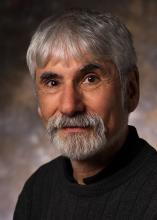Professor Donald K. Grayson, UW Professor of Anthropology and world-renowned archaeologist, has become the first current member of our department to be named to the National Academy of Sciences. This eminent institution, established by order of President Abraham Lincoln in 1863, is a veritable “who’s who” of top American scientists. In addition to being a great honor, membership in the NAS also carries great responsibility: the academy’s mission is to “investigate, examine, experiment, and report upon any subject of science or art whenever called upon to do so by any department of the government.”
For decades Professor Grayson has been a pioneer in uncovering the interrelationships between prehistoric peoples and the living landscapes that support them. He has divided his field career between work in southern Europe and in the Great Basin of the United States. At sites like Grotte XVI in southwestern France, Professor Grayson spent over a decade demonstrating that Cro-Magnons and Neanderthals had greater similarity in their diets and lifestyles than was previously believed. The results, which have now been replicated by others, helped rewrite our understanding of how these two beings co-existed, and ultimately how one prevailed.
At the same time, Professor Grayson has been toiling in remote sites in the Great Basin—like the Toquima Range of Northern Nevada—documenting the long history of Pleistocene and Holocene climate change, animal habitat reduction and extinction. From this work he has created a rich picture of how humans and the many species of desert mammals shaped each other’s histories over millennia, and how changes in climate have altered the histories of both. His work on the deeper history of pikas—small rabbit-like animals familiar to hikers in Mt. Rainier National Park—was pivotal in a petition to have these animals placed on the Federal Endangered Species List. All of these different research undertakings—and the methodological and theoretical developments that they produced—drew the attention of the NAS membership.
The work in the U.S. culminated in his recent book The Great Basin: A Natural Prehistory. In addition to all this, Professor Grayson has written on topics as wide ranging as the effects of volcanic activity on human settlement, the nature and causes of late Pleistocene extinctions, and the demographics of the Donner Party and other western migrant groups. His deep knowledge of climate change and species extinction serves him well whenever “any department of the government” chooses to consult him.
Professor Grayson has been a pivotal member of the UW Department of Anthropology since 1975. During that time he has written or edited five books, authored over 150 papers and monographs, and mentored twenty Ph.D. students on to their own distinguished careers. He credits his late wife, Barbara, a former librarian at the University of Washington, with being the guiding light throughout his life and career. He also says that when he was a child in upstate New York, he had three dreams: to be a professional first baseman, a classical violinist, or an archaeologist. Luckily for us—and for the field of bioarchaeology—he pursued option three.
Did You Know?
While Professor Grayson is the first sitting faculty member in our department named to the National Academy of Sciences, there have been other affiliates to join the Academy after their time with us. Leslie Spier, one of our founders in 1920, went on to spend most of his career at the University of New Mexico and was invited from there. More recently, two of the three anthropologists named in 2009 were alumni of our department. David Meltzer is the Henderson-Morrison Professor of Prehistory at Southern Methodist University, an expert on the first human migrations into North America—and a close friend and collaborator of Professor Grayson’s. Melvyn Goldstein is the John Reynold Harkness Professor of Anthropology at Case Western Reserve University, and a specialist in the history, culture and politics of Tibet. Our department is proud of all of these affiliates!
Photograph: Don Grayson, photo by Mary Levin, UW Photography, 2011
